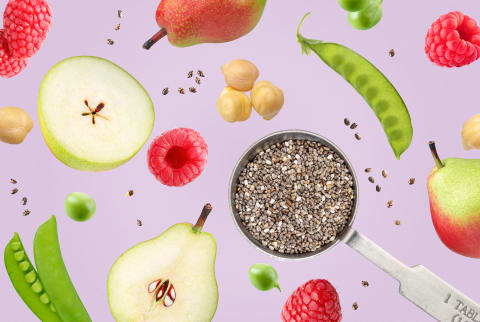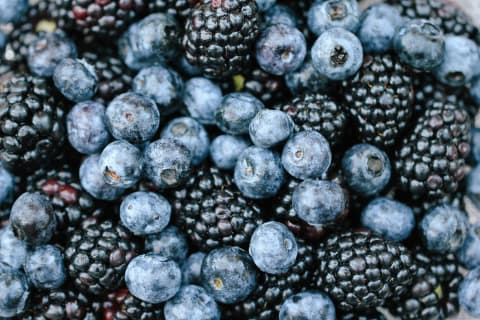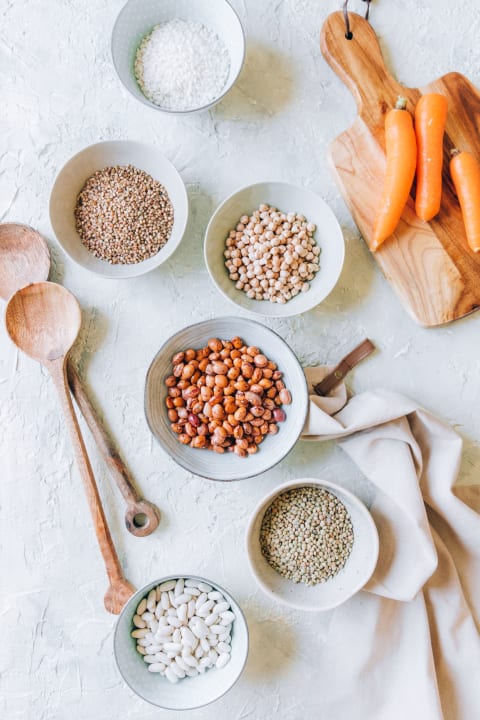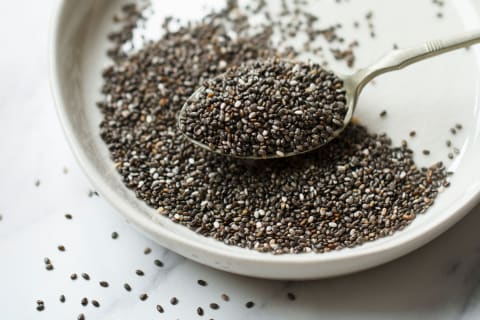Your Definitive Guide To Fiber



Sometimes when folks add more veggies and fiber-filled foods to their plate, their digestive system doesn’t cooperate very well and uncomfortable physical issues crop up. These not-so-awesome bathroom trips and embarrassing gassy moments have given fiber a bad name. But fiber really is your friend — you just have to get to know it a little better and learn a few simple fiber guidelines. Today, I hope to mend any grudges you have against fiber and show you how to live in harmony with it.
C’mon, give fiber a chance!
What is fiber?
Quite simply, fiber is plant roughage — the part of veggies, fruits, beans, grains, nuts and seeds that resists digestion. So why would you go out of your way to eat things that just come out anyway? For precisely that reason. Fiber helps clean out your digestive system and get rid of things (namely extra hormones, cholesterol, toxins and waste) that shouldn’t be there.
Fiber also provides a plethora of other health benefits, including proper colon health. In addition, fiber-rich foods are essential for a strong immune system, faster metabolism, and weight control, diabetes and cardiovascular disease prevention, beautiful skin and better overall health.
Are you beginning to see why I’m so passionate about fiber?
What’s the difference between soluble & insoluble fiber?
Insoluble fiber has a laxative effect and is found in fruit and vegetable skins, wheat, wheat bran, rye and rice. It doesn’t readily dissolve in water, so it adds to fecal bulk (poop mass). It’s crucial for hearty, healthy bowel movements, which should be excreted at least once or twice a day.

Soluble fiber absorbs liquid, swells and is readily digested by intestinal bacteria. It ferments and produces gases in the digestive tract. I know this doesn’t sound so sexy, but it’s very important for colon health. Soluble fiber creates a feeling of fullness and is the kind of fiber responsible for lowering LDL “lousy” cholesterol. You have to look a little harder for soluble fiber in the diet, but champions include chia seeds, flax seeds, oats, oat bran, barley, beans, lentils, psyllium and most fruits — especially berries.
How much fiber do you need to eat?
There’s a big difference between how much fiber the average person is eating and how much they should be eating for optimal health. The recommended intake 1for disease prevention is 14 grams of fiber for every 1000 calories consumed, which averages to at least 38 grams per day for men and 25 grams per day for women.
Many health authorities, however, recommend eating even more fiber to better your chances of overall health and wellness. However, the average American fiber intake is about half of what’s recommended — 16 to 18 grams of a day for men and 12 to 14 grams per day for women.
And let’s not leave out the kiddos! Kids eat less food and should naturally have less fiber in their diet. But, fiber is still important for their overall health, and it’s important for them to have a mix of insoluble fiber-rich veggies, wheat bran, and rice as well as soluble fiber-rich beans, seeds and berries. Loose stools are often the first sign that a child may be getting too much fiber, or an improper balance of soluble and insoluble fiber.
Why does fiber cause gas and indigestion?
Too much added fiber, too fast
An increase in total fiber, especially a jump too quickly can cause gas and bloating. But, it’s really the fermentation of soluble fiber in the colon that produces these issues. Soluble fiber hits the colon undigested, and when the gut bacteria work to break it down, gas results. A-ha! This is why the childhood song pokes fun at beans as the “musical fruit” and not lettuce — beans have a great deal of soluble fiber, lettuce has mostly insoluble fiber. Keep in mind that beans or no beans, it is actually normal to pass gas 13 to 21 times a day. Yes, I said it’s normal. Fart-tastic!

Digestive disorders
Irritable bowel syndrome and other digestive disorders affect how much gas moves through the intestinal tract and can increase intestinal gassiness as well as bloating and painful discomfort. Like anyone new to a high-fiber diet, folks with sensitive or otherwise challenged digestive systems should increase fiber intake slowly and ensure a mix of both insoluble and soluble fiber-rich foods.
Soluble fiber, like the kind found in chia seeds and flax seeds, helps to soften stools and make happy bowel movements with minimal discomfort. Raw vegetables and cruciferous vegetables may provide special challenges for those with digestive disorders. If this is the case, eating smaller quantities or cooking veggies thoroughly may give some relief.
You’re not drinking enough water
To avoid constipation (which often goes along with extra gas and bloating), be sure to increase fluid intake as you increase fiber intake. If you’re dehydrated, your body pulls water from your food waste, making your poop more difficult to pass. Women need (on average) at least 2 liters of water a day and men need at least 3 liters a day. You can also calculate this by dividing your body weight in half and drinking that quantity of water in ounces (a person who weighs 200 pounds needs to drink 100 ounces water daily).
The rest of the culprits
Eating too fast, smoking, chewing gum, not chewing your food thoroughly, drinking carbonated beverages, eating lactose found in dairy products, even chowing on too much fructose (fruit sugar), and loading up on too many raffinose-heavy foods like beans, broccoli, cauliflower and cabbage can increase gas production.
In case you’re curious, raffinose is a hard-to-digest sugar. Kombu (a seaweed) helps break it down, therefore making it easier to digest. (I share my tip for using kombu while cooking below.) A diet too high in fatty foods can also increase bloating and digestive discomfort. Fatty foods (even of the healthier fat variety) slow down stomach emptying and lower the transit time of foods through the digestive system. This gives the body extra time to get gassy and uncomfortable.
Do the root causes we just covered sound familiar? If so, read on and learn how to live a thriving and comfortable high-fiber life.
How to calm digestion and prevent gas while eating fibrous foods
Here are some easy ways you can increase healthy, fibrous foods while avoiding pesky digestive issues:
Ease into eating more fiber slowly.
Add 5 grams of fiber (the amount in 1 large serving of vegetables, 1/3 cup of cooked beans or lentils, or 1 ½ servings of fruit) no sooner than every 3 days. Trampolining into too much fiber too fast is a guarantee that you’ll get gassy, bloated, and perhaps have too many bathroom trips. And chances are, you’ll blame the fiber and go back to your old low-fiber ways.
Once your system is used to the added 5 grams of fiber, add another 5 grams. The minute you feel discomfort, scale back slightly and try again in 3 more days. Keep going until you’re fiber-strong! It often takes a month or more to fully transition to a superpower high-fiber diet. And don’t forget to increase water intake as your fiber intake increases — at least 2 liters for women and 3 liters for men daily.

Balance soluble and insoluble fiber.
If gas persists, replace some of the soluble-fiber rich foods (beans, lentils, split-peas, berries, chia seeds, oats, flax) with foods rich in insoluble fiber (veggies, fruit, wheat, wheat bran, and brown rice). Soluble fiber is often to blame for gassiness and insoluble fiber helps move things out more quickly allowing for less gassy time potential.
Cook beans with kombu.
After soaking dried beans overnight (or at least a few hours) and before boiling them, drain the soaking water (it contains some gas-causing compounds), add new filtered water and a strip of dried kombu seaweed (found at any health food store). The kombu contains enzymes (unlike our digestive tracts) that breakdown the gas-causing raffinose simple sugars in beans and cruciferous veggies.
Eliminate high-fat and fried foods.
Fat slows stomach emptying and can increase gas and bloating. Reduce even healthy fats like nuts, avocados, seeds and healthy oils to see if fat may be the culprit.
Chew slowly and avoid carbonated beverages and gum.
The less gas you consume, the less gas that has to get out. Simple!
Add fresh ginger to meals.
Ginger is a big-time gas reliever, digestion easer and nausea and motion sickness remedy. Add ginger to stir-fries, green juice and bean dishes. Enjoy hot ginger tea before and after meals or a teaspoon of fresh grated ginger before meals.
Take a probiotics supplement and eat probiotic foods.
Probiotics help restore good bacteria and ease digestion. Foods that are naturally high in probiotics include pineapple, tempeh, kimchi, natto, sauerkraut and miso. Or supplement with a high-quality probiotic like Dr. Ohirra’s, Primal Defense, Healthforce Nutritionals (Friendly Force) and MegaFood’s Megaflora.
Exercise.
Any cardiovascular exercise that strengthens your abdominal muscles (walking, running, bicycling) also helps strengthen your digestive muscles. This eases digestion. Plus, getting your heart rate up also increases your intestinal speed. Less time in the tract can often help alleviate gas. Certain yoga poses that increase blood flow to the digestive tract, like the seated spinal twist can also help soothe indigestion.
Wheel out trapped gas.
Lay on the floor, legs up in the air and move them in a bicycle motion. Wheee! Trapped gas can be really painful, and this exercise will help you get some relief.
Now that we’ve covered the benefits of fiber and how to overcome the common issues associated with eating fiber-rich foods, do you think you can try to make things work with this amazing and essential part of your diet?

Kris Carr is a New York Times best-selling author, speaker and health advocate. She is the subject and director of the documentary, Crazy Sexy Cancer, which aired on TLC and The Oprah Winfrey Network. Kris is also the author of the award-winning Crazy Sexy Cancer book series. Her latest books, Crazy Sexy Diet and Crazy Sexy Kitchen, will change the way you live, love and eat! Kris regularly lectures at hospitals, wellness centers, corporations such as Whole Foods, and Harvard University. In addition to writing for Kriscarr.com, she regularly contributes articles to The Huffington Post, Prevention.com and Natural Health Magazine. Media appearances include: Good Morning America, Today, The Early Show, CBS Evening News, Access Hollywood, The Doctors, The Gayle King Show, Super Soul Sunday and The Oprah Winfrey Show. As an irreverent foot soldier in the fight against disease, Kris inspires countless people to take charge of their health and happiness by adopting a plant-passionate diet, improving lifestyle practices, and learning to live and love like you really mean it. Her motto: Make juice not war!